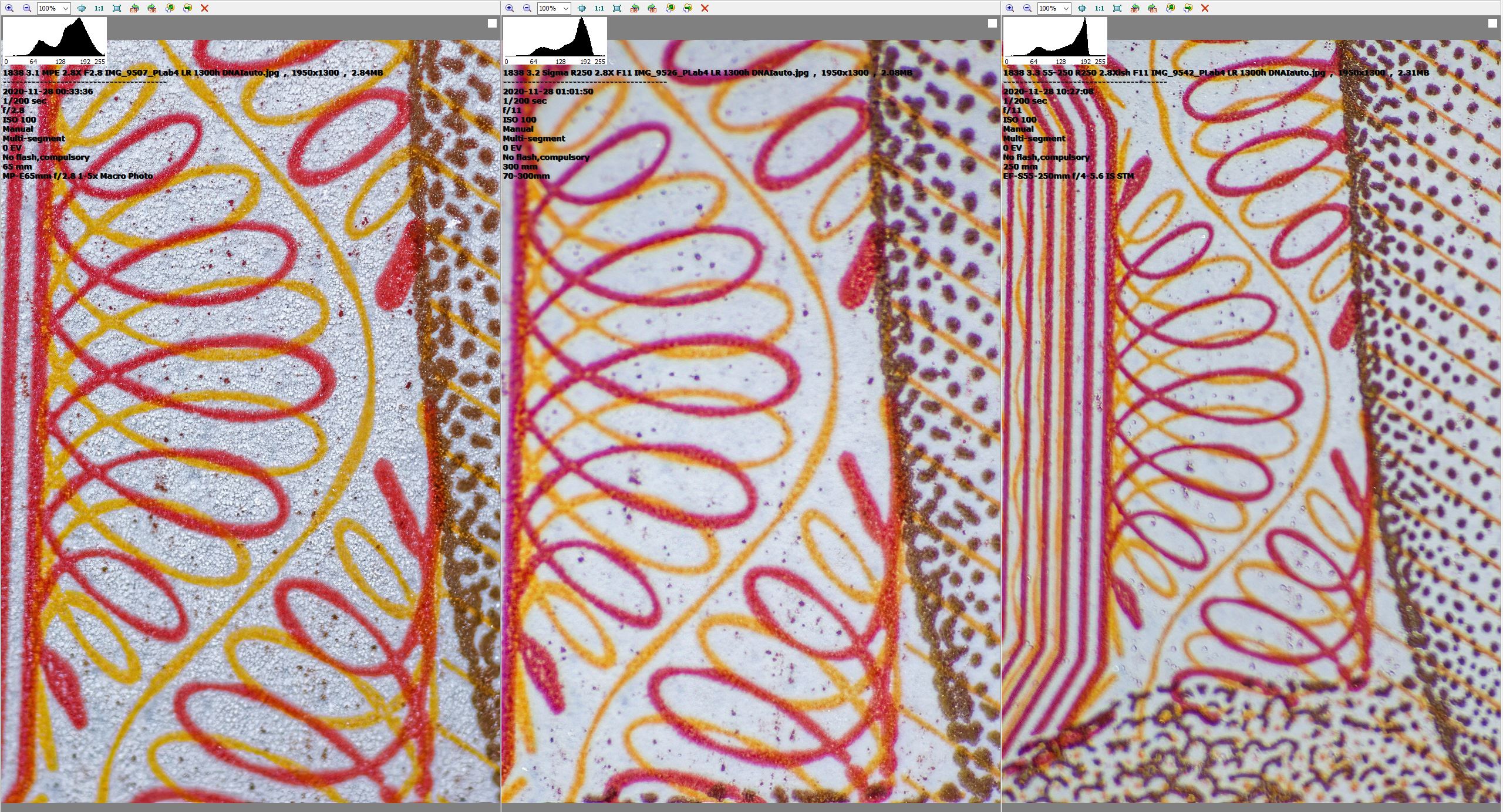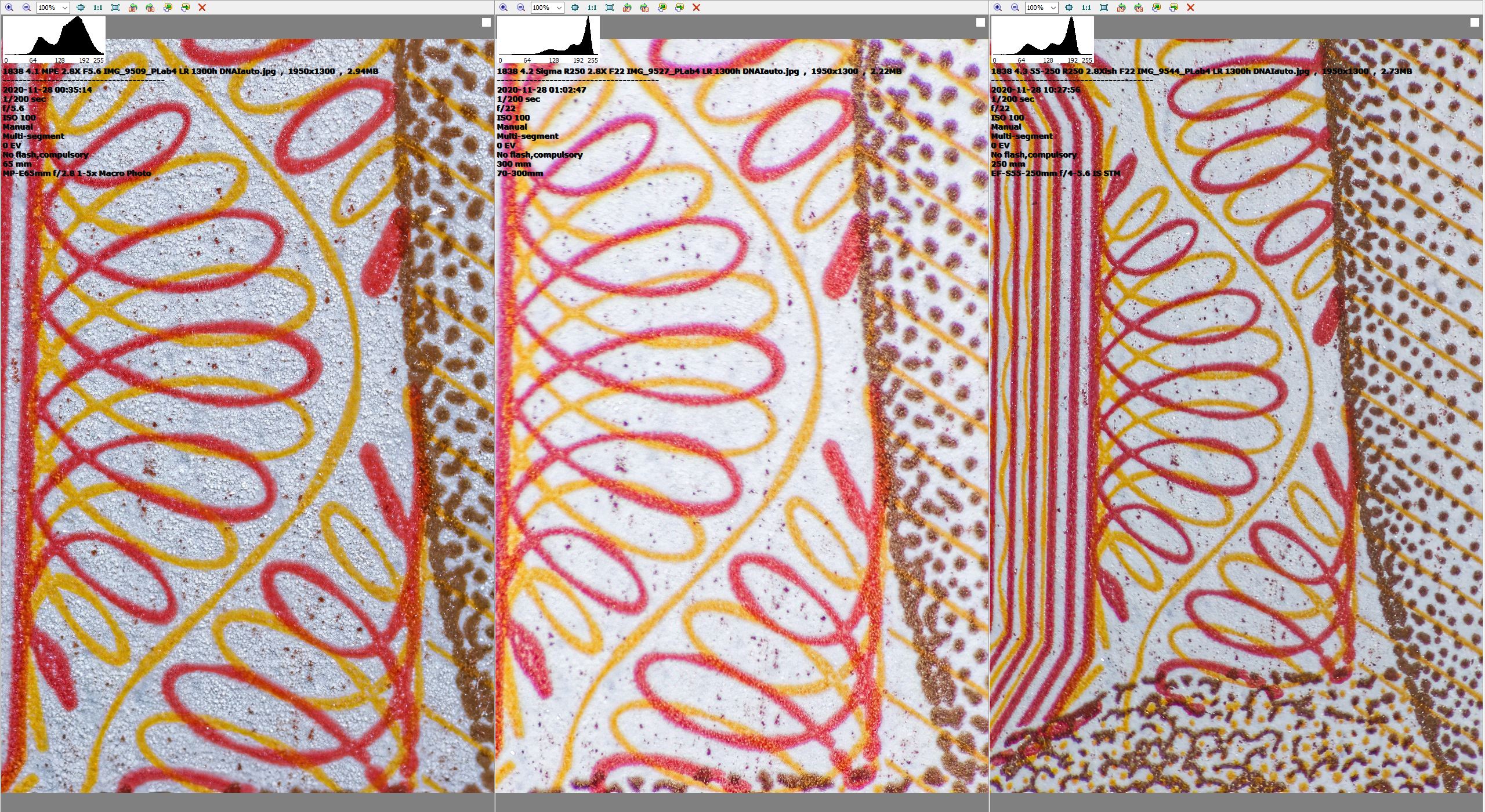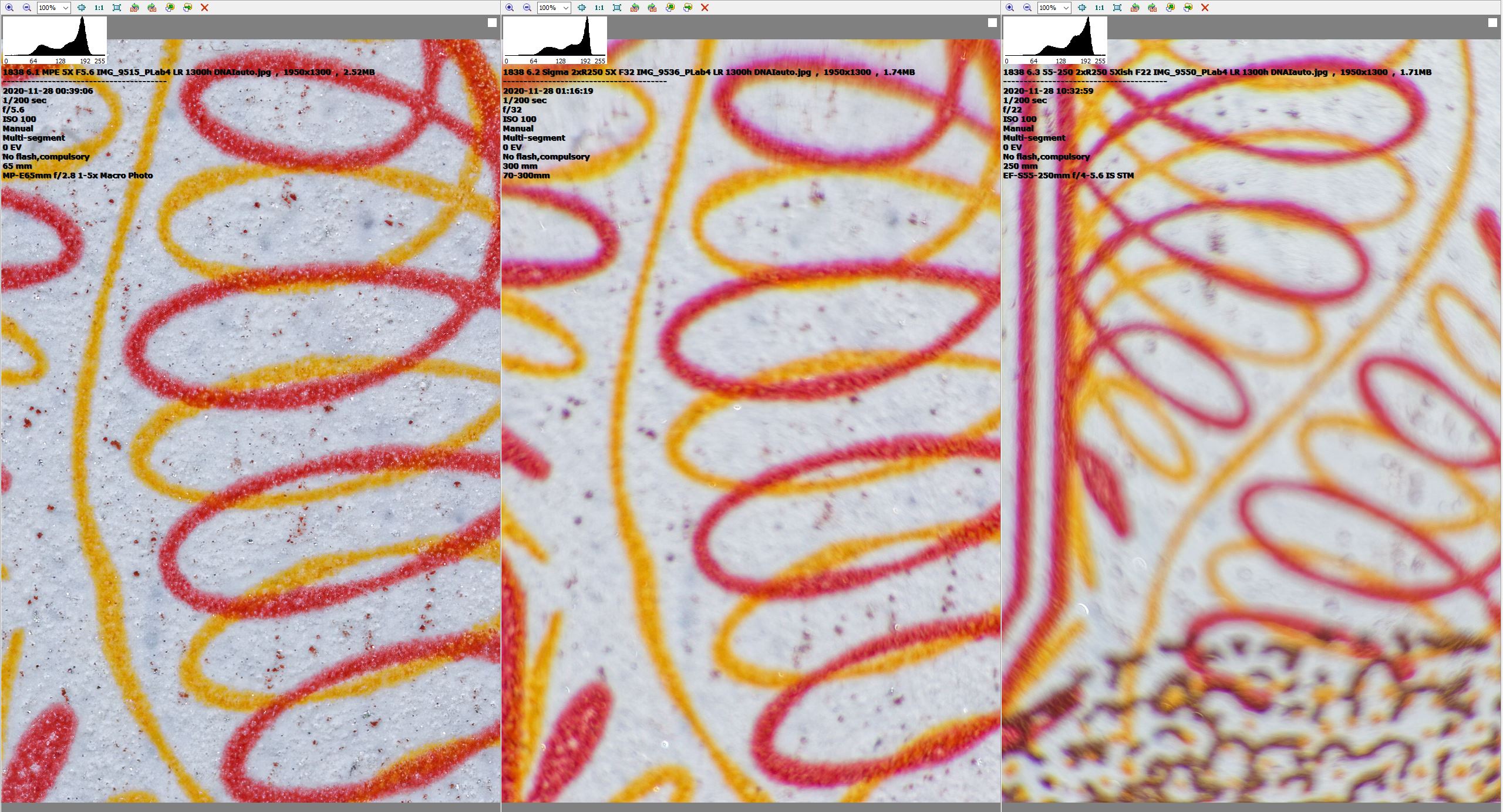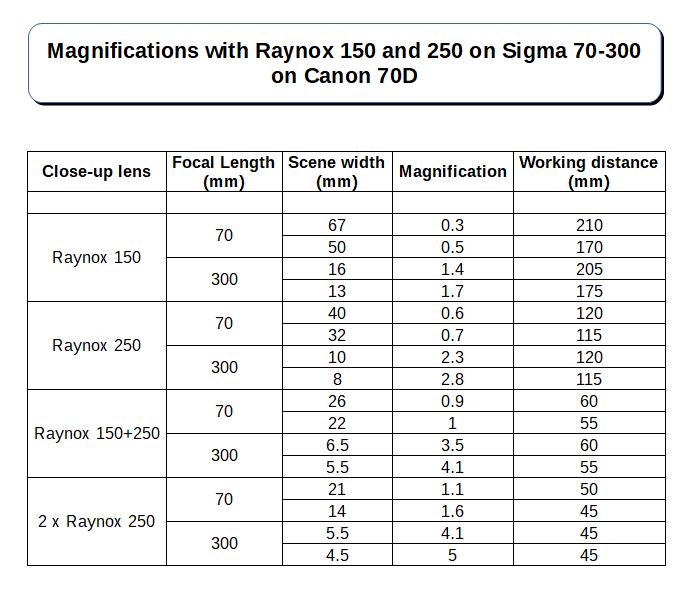I wouldn't expect the image quality to be as good as with the MPE-65, especially at the higher magnifications. I don't know how much difference it would make in practice, given that you'll probably be well into in diffusion softening territory anyway, and that evens things out somewhat as far as image quality goes. I might do some banknote comparison tests to have a look at that, although translating those tests into practical differences out in the field can be a bit iffy. Still, it might be reassuring, or on the other hand it might give a clear warning.
I've done some banknote comparisons. As always, I might have messed it up, but there seems to be a very clear message from it - don't go down the close-up lens route.
Using flash, I captured banknote images at 1X, around 2.8X and 5X using the MPE-65 on a Canon 70D, using effective apertures of f/11 and f/22 for each magnification. I then captured matching images using, respectively, a Raynox 150, a Raynox 250 and two Raynox 250s on a Sigma 70-300 on the 70D.
The results from the Sigma at 2.8X and 5X were so poor that I wanted to find out it the problem was with the Sigma (which I haven't used much and so don't have any feel for) or the use of close-up lenses. So I repeated the captures using a Raynox 150, Raynox 250 and two Raynox 250s on a Canon EF-S 55-250 on the 70D. This is a lens I have used a lot and have felt the images I captured with it using a 150 and 250 have been ok. I'm not sure I ever used it with stacked close-up lenses. I couldn't quite match the magnifications, and I made a mistake of one stop with the aperture for the pair of 5Xish captures, but the overall picture seemed pretty clear. The results were no better than with the Sigma. I'm rather surprised about this, given that I got some nice results with the 55-250 and Raynox 150 and 250 on the 70D, but unless I really messed up the tests in some way, for both the Sigma and the Canon 55-250, the conclusions seem clear to me.
Incidentally, these poor results from the close-up lenses are consistent with the fact that I was using 10X screen magnification in manual focus mode to try to get the focus spot on, but I found this a lot more difficult to do with the Sigma and the 55-250 than with the MPE. Despite using a tripod, at 2.8X and 5X magnification and using 10X screen magnification the focus bobbled around madly when I touched the camera to change the focus, with the image going in and out of focus. And when I let go of the camera it settled to a different place from where I had set the focus, so it was a try and try again thing to try to get it to settle at the right place. With the MPE-65 the textures on the banknote would show up clearly when the rig settled in the right place. With both close-up lens setups I only got a very soft view on the screen which never showed me the textures like the MPE did, so there was an element of guesswork about exactly when it was in best focus.
I only took one shot for each combination rather than using repetition as I usually do and picking the best one. There can be a lot of shot to shot variation with these tests. However, the overall picture is so clear and consistent that I think it unlikely that shot to shot variation is masking the underlying picture of what is going on.
Here are six comparisons. I shot raw and processed using my usual pipeline of PhotoLab, Lightroom and DeNoise AI, using the same presets in each case, and no hand-crafting on top of that. This is very strong processing (which I use for my much softer, tiny aperture shots) and it resulted in the MPE images being over-processed, but I don't think that changes the overall interpretation.
These comparisons show 1300 pixel high versions at 100%. The differences are so large that they show up here at my normal output size. There is no need to pixel peep looking for subtle differences. The MPE is on the left, the Sigma in the middle and the Canon 55-250 on the right.
For 1X and 2.8X I shot the Sigma at f/11 and f/22. I adjusted the f-numbers of the MPE according to the magnification to give matching effective apertures of f/11 and f/22. For the 5X pairs I shot the Sigma at f/16 and f/32 because f/16 was the largest effective aperture I could get with the MPE at 5X (f/2.8 * (1+5))=f/16). I shot the Canon 55-250 at f/11 and f/22 for all three pairs, having forgotten to use f/16 and f/32 for the 5Xish shot. (I couldn't quite get to 5X with the 55-250, and similarly I couldn't quite match the 2.8X shot, but I think both are near enough to tell the story ok.)
Click through to Flickr to see the 1300 pixel high versions and click again once there to get them full size. That makes the differences show up much clearer than here.
Magnification 1X, effective aperture f/11.
 1838 7.1 3-way 1X effectiveF11 100pc of 1300h
1838 7.1 3-way 1X effectiveF11 100pc of 1300h by
gardenersassistant, on Flickr
Magnification 1X, effective aperture f/22
 1838 7.2 3-way 1X effectiveF22 100pc of 1300h
1838 7.2 3-way 1X effectiveF22 100pc of 1300h by
gardenersassistant, on Flickr
Magnification around 2.8X (less for the Canon 55-250), effective aperture f/11
 1838 7.3 3-way 2.8Xish effectiveF11 100pc of 1300h
1838 7.3 3-way 2.8Xish effectiveF11 100pc of 1300h by
gardenersassistant, on Flickr
Magnification around 2.8X (less for the Canon 55-250), effective aperture f/22
 1838 7.4 3-way 2.8Xish effectiveF22 100pc of 1300h
1838 7.4 3-way 2.8Xish effectiveF22 100pc of 1300h by
gardenersassistant, on Flickr
Magnification around 5X (less for the Canon 55-250), effective aperture f/16 (f/11 for the 55-250)
 1838 7.5 3-way 5Xish effectiveF16,F16,F11 100pc of 1300h
1838 7.5 3-way 5Xish effectiveF16,F16,F11 100pc of 1300h by
gardenersassistant, on Flickr
Magnification around 5X (less for the Canon 55-250), effective aperture f/32 (f/22 for the 55-250)
 1838 7.6 3-way 5Xish effectiveF32,F32,F22 100pc of 1300h
1838 7.6 3-way 5Xish effectiveF32,F32,F22 100pc of 1300h by
gardenersassistant, on Flickr
 extreme-macro.co.uk
extreme-macro.co.uk




 1838 7.1 3-way 1X effectiveF11 100pc of 1300h
1838 7.1 3-way 1X effectiveF11 100pc of 1300h 1838 7.2 3-way 1X effectiveF22 100pc of 1300h
1838 7.2 3-way 1X effectiveF22 100pc of 1300h 1838 7.3 3-way 2.8Xish effectiveF11 100pc of 1300h
1838 7.3 3-way 2.8Xish effectiveF11 100pc of 1300h 1838 7.4 3-way 2.8Xish effectiveF22 100pc of 1300h
1838 7.4 3-way 2.8Xish effectiveF22 100pc of 1300h 1838 7.5 3-way 5Xish effectiveF16,F16,F11 100pc of 1300h
1838 7.5 3-way 5Xish effectiveF16,F16,F11 100pc of 1300h 1838 7.6 3-way 5Xish effectiveF32,F32,F22 100pc of 1300h
1838 7.6 3-way 5Xish effectiveF32,F32,F22 100pc of 1300h